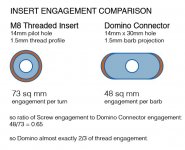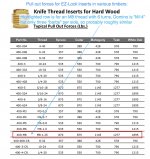Cheese said:I think Festool is only suggesting that these Dominos can withstand a high pullout force relative to the standard knockdown components that are currently available.
I understand you would like these to work in your application but that’s just not feasible.
The Domino has 3 ridges on each side that digs into the wood, consider these to be the equivalent of 3 screw threads. How much load will a 14mm screw support when only 3 threads are engaged?
Also when using a screw, a pilot hole is drilled and the screw manufactures its own internally threaded coupling. There is line-to-line contact between the wood and the fastener for 360 degrees.
With a Domino, a clearance hole is used and the only line-to-line contact are the sides of the 3 ridges. Maybe...maybe there is 180 degrees of contact. However you’re still relying on the 3 ridges to “push themselves” into line-to-line contact with the wood as opposed to being “driven” into contact.
So take a 14mm screw, engage only 3 threads, derate it by at least 50% for lack of peripheral contact reasons and you’ll probably be close to the pullout spec of the Domino. I don’t know what that is but it’d be interesting.
Hi Cheese, well for an inanimate dairy product you've given me a very well reasoned and useful answer ;-) thank you.
I think pretty much everything you state makes sense, and I agree with your analysis of the Festool connector profile relative to a 360º screw thread. I might give it a bit more than the 180º you give it, there is effectively a "crescent moon" shape of engagement for each barb profile, i've done a quick comparison, and assuming equivalent thread depth, I get almost exactly 2/3.
[attachimg=1]
Another advantage the Festool Connector has is that unlike the conventional insert which has both a helical thread form, so some of the pull out is tranlated to twist, and also a V form thread which slightly ramps out under load whereas the Festool connector has effectively a barb once deployed which slightly digs in under load.
Here is a manufacturer, ezlok.com, of threaded inserts who helpfulluy and not that unusually, give a range of pull-out values for various timbers for each of their inserts for furniture making. For the M8 insert (I'm assuming that 8mm is the internal machine screw thread for the mating part, and not the external one) the pull out forces seem to range from about 850lbs (385kg) for Spruce to 1900lbs (860kg) per connector for White Oak depending on wood type.
[attachimg=2]
So, just very roughly, for an "L" lever, where the long arm is the 800mm long tread with say a short arm being 150mm distance from pivot to insert centre line.
Each insert is capable of supporting :
850lbs x (150/800) = 160 lbs (72kg) at the extremity of the tread for the worst case timber, Spruce
1900lbs x (150/800) = 360 lbs (163 kg) at the extremity of the tread for the worst case timber White Oak.
Obviously this is only static loading and not dynamic, and no safety margin, but its quite a large person standing on the end of the tread on the White Oak staircase ;-)
So perhaps I just use some cheap threaded inserts... but dividing by 2/3 still gives a pretty good value per Domino.
All theoretical I know as far as the Dominoes as no data available, but even if with their "extremely high pull-out and load forces" they were only half as good on pull-out as a cheap threaded insert, they are in the right order of magnitude to be viable.
So, perhaps the only part I might not end up agreeing with you on Cheese, is the "I understand you would like these to work in your application but that’s just not feasible". They might not be reccomended for it, and obviously innovation with them is heavily discouraged by Festool, but if they are half as good as a threaded insert they might be feasible.
Only tests will tell.
Thanks again for your useful input anyhow. Sadly, more useful than Festool's by a factor of 10 at least.
Cheers
Stephen





